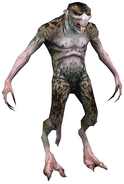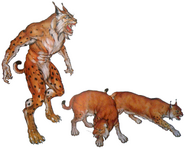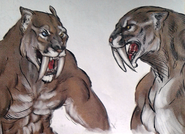A therianthrope[1] is a human or a member of another humanoid race who, due to a curse, magical ritual, or other circumstances, is affected by therianthropy: a magical "disease" which changes the "contaminated" into an animal or human-animal hybrid during a full moon. During these three nights every month, the therianthrope is not able to control themself and may be lethally dangerous to those nearby. Despite folk tales, being bitten by a therianthrope very rarely results in acquiring the illness.[2]
One should not compare them to other shapeshifting creatures such as aguaras, which are antherions — that is, animals that are able to take a humanoid form[1] — nor those who can polymorph, which is a rare magical ability that allows one to take a different form at will, either as an innate ability or through years of magical study.
History[]

A werecat terrorizing Creigiau forests accompanied by his pumas.
Therianthropy diseases appeared in the world after the Conjunction of the Spheres, affecting nonhuman and early human populations alike.[2] Entire regions such as the Toina valley, also called the Dogbane, were said to be plagued by werewolves before the Nordling colonization.[3]
On Skellige, a group of Svalblod worshippers invented a "controllable" way to become werebears. During a complicated ritual involving psilocybe mushrooms and what seemed to be allowing wild bears to eat the cultists alive, the fierce warriors known as the Berserker used to rise. The bloodlust of Svalblod worshippers and their leader, Jarl Knut the Callous, ultimately led the Islanders to banish the cult and destroy the sacred sites of the werebear god.[4][5]
Characteristics[]
An important difference between therianthropes and other Cursed Ones is that therianthropy is hereditary. Those who have inherited it from one of their parents (instead of via another circumstance) are fully capable of controlling their abilities and might change between one or three forms whenever they wish, not being limited to just during a full moon.[1][6]
Therianthropes may live either among other humans, blending into society,[7] or in the wild to avoid harming others.[6] They do not like vampires[2] (with the feeling being mutual),[8] and tend to hold internal grudges towards therianthropes of different types. That said, they are often friendly with the animals they can transform into[2] and may sometimes even hunt with them.[6]
Treatment[]
The only known method to treat therianthropy without killing them is to lift the curse placed on the individual. It is said that this requires great pain and or personal loss[9] but other remedies such as wolfsbane or "finding true love" are said to sometimes work.[7] However, such treatments only work for those who didn't inherit therianthropy. For those who did inherit it, it cannot be removed as their ability did not result from a curse.[1][6]
If the bestial nature of a therianthrope starts to dominate over the sentient half to the point they start harming others regularly and they refuse or cannot have the curse removed, sadly the only choice left is usually to hire a witcher in order to end their killing.
Notable therianthropes[]
- Otto Dussart (werewolf)
- Vincent Meis (werewolf)
- Anton the Bearded (werecat)
- Anton the Younger (werecat)
- Morkvarg (werewolf)
- Niellen (werewolf)
- Kopek Grimm (weredog)
Notes[]
- Despite their name, werebbubbs are not therianthropes. "Were-" part stands for "were", an archaic term for a male human. However, in the original Polish edition, they are called "bobołaks", where "-łak" has the elder meaning, coming from the Proto-Slavic lakъ, meaning "skin". Bobołak is also just one of many variants/spellings of similarly named creatures across numerous cultural folklores that can be roughly translated as "bogey-skinned'" or "bogey-man".




